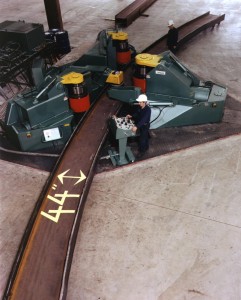Bending steel sections can involve both curving and cambering.
In the world of structural steel, camber denotes a curve in the vertical plane; sweep denotes a curve in the horizontal plane. Steel members produced in a steel mill have at least some camber and some sweep. The allowed amount of deviation from straight is defined by the tolerances specified in ASTM A6/A6M.
The American Standards for Testing Materials (ASTM) is an international organization that creates and publishes a concensus of technical standards for a wide range of materials. A6/A6M is the standard specification for general requirements for rolled structural steel bars, plates, shapes, and sheet piling. (Note: “rolled” here means that the steel was produced by running it through rollers to create straight members.)
There are occasions, however, when camber and sweep are required in a structural steel application. For example, cambered beams may offer superior support in a building by reducing any sag from the weight of a concrete floor. A canopy may be supported by a beam with sweep that creates an edge curved the “easy way,” i.e. against the weak axis.
Camber can be induced in a structural member in several ways. Probably the most common is cambering on what is called a “cambering machine,” a device that holds a steel section at two points and then applies pressure through one or two hydraulic cylinders to a point between the two points.
Camber can also be put in a structural member by the careful application of heat. Skilled workers can do this, but the results are sometimes unpredictable.
Another method to induce camber is to use a three-roll section bender. These machines are also called “angle rolls,” “profile benders,” or “structural benders.”

The questions sometimes arises as to what is the difference between a camber and a curve. Normally, a camber has a rather small mid-ordinate rise, say 1/2 to 3 inches over 40ft. A uniform curvature is typically not required, but, on the other hand, a uniform curvature can provide a specified camber. A camber can be put in a beam simply by applying pressure with a cambering machine in the middle of the beam.
Curving indicates both large and small radii, say from 1000ft radius to 10ft radius. To the best of our knowledge, there is no definition of camber that references a radius, i.e. a definition that says that a radius of a given value is no longer a camber but now a curve.
According to the American Institute of Steel Construction (AISC) Code of Standard Practice there are different tolerances for a camber and for a curved structural steel section. Section 6.4.4, indicates the tolerances for beam camber. Without getting into the details, camber tolerances are usually minus zero plus x measured at the mid-ordinate rise. Section 6.4.2 indicates the tolerances for a curved structural member. Again, without getting into details, curved steel tolerances specify that the variation from the theoretical curvature–measured along the arc–shall be equal to or less than the variation in straightness of an equivalent straight member as prescribed on ASTM A6/A6M.







